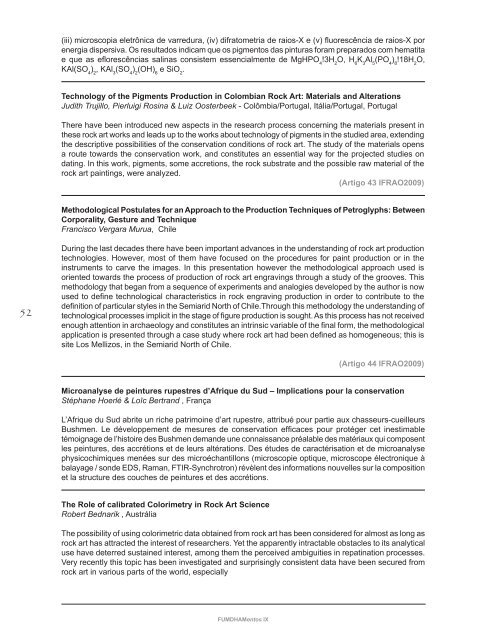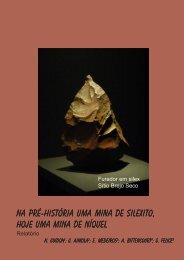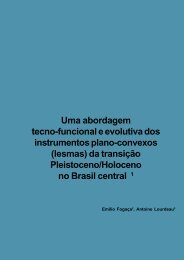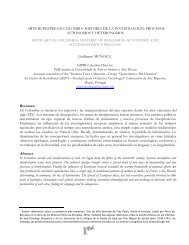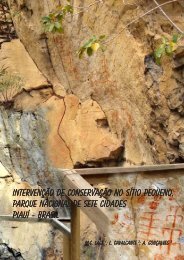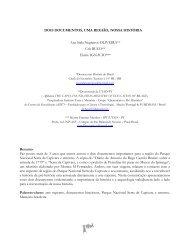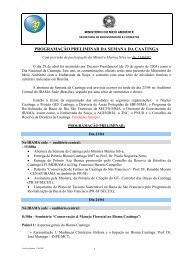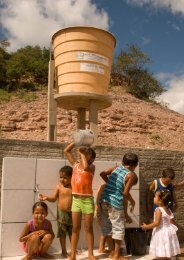Untitled - Fundação Museu do Homem Americano
Untitled - Fundação Museu do Homem Americano
Untitled - Fundação Museu do Homem Americano
You also want an ePaper? Increase the reach of your titles
YUMPU automatically turns print PDFs into web optimized ePapers that Google loves.
(iii) microscopia eletrônica de varredura, (iv) difratometria de raios-X e (v) fluorescência de raios-X por<br />
energia dispersiva. Os resulta<strong>do</strong>s indicam que os pigmentos das pinturas foram prepara<strong>do</strong>s com hematita<br />
e que as eflorescências salinas consistem essencialmente de MgHPO 4<br />
!3H 2<br />
O, H 6<br />
K 3<br />
Al 5<br />
(PO 4<br />
) 8<br />
!18H 2<br />
O,<br />
KAl(SO 4<br />
) 2<br />
, KAl 3<br />
(SO 4<br />
) 2<br />
(OH) 6<br />
e SiO 2<br />
.<br />
Technology of the Pigments Production in Colombian Rock Art: Materials and Alterations<br />
Judith Trujillo, Pierluigi Rosina & Luiz Oosterbeek - Colômbia/Portugal, Itália/Portugal, Portugal<br />
There have been introduced new aspects in the research process concerning the materials present in<br />
these rock art works and leads up to the works about technology of pigments in the studied area, extending<br />
the descriptive possibilities of the conservation conditions of rock art. The study of the materials opens<br />
a route towards the conservation work, and constitutes an essential way for the projected studies on<br />
dating. In this work, pigments, some accretions, the rock substrate and the possible raw material of the<br />
rock art paintings, were analyzed.<br />
(Artigo 43 IFRAO2009)<br />
Metho<strong>do</strong>logical Postulates for an Approach to the Production Techniques of Petroglyphs: Between<br />
Corporality, Gesture and Technique<br />
Francisco Vergara Murua, Chile<br />
52<br />
During the last decades there have been important advances in the understanding of rock art production<br />
technologies. However, most of them have focused on the procedures for paint production or in the<br />
instruments to carve the images. In this presentation however the metho<strong>do</strong>logical approach used is<br />
oriented towards the process of production of rock art engravings through a study of the grooves. This<br />
metho<strong>do</strong>logy that began from a sequence of experiments and analogies developed by the author is now<br />
used to define technological characteristics in rock engraving production in order to contribute to the<br />
definition of particular styles in the Semiarid North of Chile.Through this metho<strong>do</strong>logy the understanding of<br />
technological processes implicit in the stage of figure production is sought. As this process has not received<br />
enough attention in archaeology and constitutes an intrinsic variable of the final form, the metho<strong>do</strong>logical<br />
application is presented through a case study where rock art had been defined as homogeneous; this is<br />
site Los Mellizos, in the Semiarid North of Chile.<br />
(Artigo 44 IFRAO2009)<br />
Microanalyse de peintures rupestres d’Afrique du Sud – Implications pour la conservation<br />
Stéphane Hoerlé & Loïc Bertrand , França<br />
L’Afrique du Sud abrite un riche patrimoine d’art rupestre, attribué pour partie aux chasseurs-cueilleurs<br />
Bushmen. Le développement de mesures de conservation effi caces pour protéger cet inestimable<br />
témoignage de l’histoire des Bushmen demande une connaissance préalable des matériaux qui composent<br />
les peintures, des accrétions et de leurs altérations. Des études de caractérisation et de microanalyse<br />
physicochimiques menées sur des microéchantillons (microscopie optique, microscope électronique à<br />
balayage / sonde EDS, Raman, FTIR-Synchrotron) révèlent des informations nouvelles sur la composition<br />
et la structure des couches de peintures et des accrétions.<br />
The Role of calibrated Colorimetry in Rock Art Science<br />
Robert Bednarik , Austrália<br />
The possibility of using colorimetric data obtained from rock art has been considered for almost as long as<br />
rock art has attracted the interest of researchers. Yet the apparently intractable obstacles to its analytical<br />
use have deterred sustained interest, among them the perceived ambiguities in repatination processes.<br />
Very recently this topic has been investigated and surprisingly consistent data have been secured from<br />
rock art in various parts of the world, especially<br />
FUMDHAMentos IX


